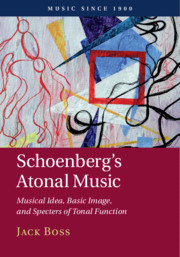Book contents
- Schoenberg’s Atonal Music
- Music Since 1900
- Schoenberg’s Atonal Music
- Copyright page
- Dedication
- Contents
- Music Examples
- Acknowledgments
- Abbreviations and Notational Conventions
- 1 Tonal oder Atonal?
- 2 Piano Pieces Op. 11, Nos. 2 and 3
- 3 Das Buch der hängenden Gärten, Op. 15, Nos. 7 and 11
- 4 Erwartung, Op. 17
- 5 Six Little Piano Pieces, Op. 19 (Nos. 2, 3, and 6)
- 6 Pierrot lunaire, Op. 21, Nos. 1, 14, and 21
- 7 Summary, and the Way Forward to Twelve-Tone Music
- Bibliography
- Index
- By the same author
6 - Pierrot lunaire, Op. 21, Nos. 1, 14, and 21
Basic Image at the Apex of Its Development
Published online by Cambridge University Press: 28 June 2019
- Schoenberg’s Atonal Music
- Music Since 1900
- Schoenberg’s Atonal Music
- Copyright page
- Dedication
- Contents
- Music Examples
- Acknowledgments
- Abbreviations and Notational Conventions
- 1 Tonal oder Atonal?
- 2 Piano Pieces Op. 11, Nos. 2 and 3
- 3 Das Buch der hängenden Gärten, Op. 15, Nos. 7 and 11
- 4 Erwartung, Op. 17
- 5 Six Little Piano Pieces, Op. 19 (Nos. 2, 3, and 6)
- 6 Pierrot lunaire, Op. 21, Nos. 1, 14, and 21
- 7 Summary, and the Way Forward to Twelve-Tone Music
- Bibliography
- Index
- By the same author
Summary
Chapter 6 presents Pierrot lunaire as autobiographical. It portrays Schoenberg being led astray into atonality by the moonlight, suffering the consequences (alienation from his audience, excoriation by the critics), and attempting to return to his older style but falling short. These different stages of Pierrot/Schoenberg’s journey are depicted by “basic images” that control the pitch and rhythmic organization. I explain three of them in detail: in “Mondestrunken,” the image of moonlight streaming down towards the composer in waves gives rise to chains of tetrachords linked by common pitch classes, that is, weak and strong Rp relations, and in “Die Kreuze” the image of musical works as crosses on which the composer is crucified is depicted by horizontally and vertically symmetrical pitch and pitch-class configurations that move around to various axes of symmetry, before locking in with finality to a single axis. In “O alter Duft” the journey homeward that becomes only a fairytale at the last minute provides an opportunity for Schoenberg to use specters of tonal function as text-painting devices, by repeatedly setting up for tonal cadences and then thwarting them at the last minute.
Keywords
- Type
- Chapter
- Information
- Schoenberg's Atonal MusicMusical Idea, Basic Image, and Specters of Tonal Function, pp. 263 - 342Publisher: Cambridge University PressPrint publication year: 2019



